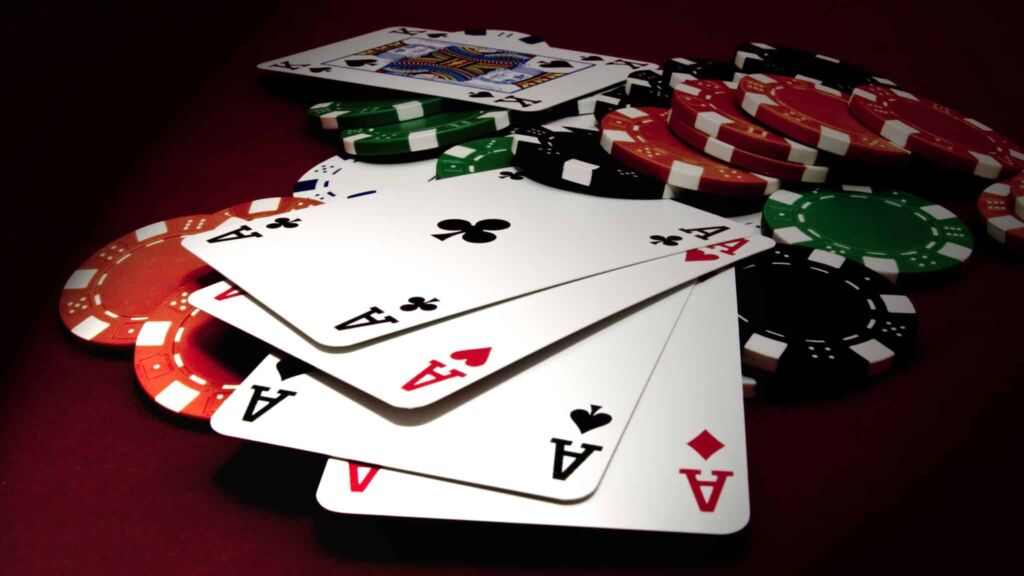Comprehending fold equity is essential for optimizing your decision-making process in online poker. It's particularly pivotal in a modern, cutthroat poker environment where players possess heightened skills and play more assertively. By efficiently utilizing fold equity, your chances of success can greatly improve.
What is Fold Equity?
Fold equity fundamentally represents the likelihood that an opponent will decide to fold when presented with your bet or raise, allowing you to seize the pot without needing the strongest hand in a showdown. This strategic element is integral to an aggressive poker strategy, especially within games like no-limit Texas Hold’em and Pot-Limit Omaha. Unlike succeeding at showdown with the best hand, fold equity offers a pathway to winning by compelling players with weaker hands to fold. Its importance grows as you evolve beyond merely playing strong opening hands, enabling you to take advantage of opponents' behaviors and the texture of the community cards.
To put this into perspective, consider a head-to-head match on the river. The board might show possible completed draws, and you hold a modest hand likely losing in a showdown. A well-timed and appropriately-sized bet can mislead your opponent into folding a hand that could be superior. This is the essence of fold equity: capitalizing on the situation not because you have a superior hand, but because your wagering dissuades your opponent.
The Importance of Fold Equity in Online Poker Scenarios
In online poker settings, where gaining insights is largely based on statistical analysis and betting trends rather than reading physical cues, leveraging fold equity becomes exceedingly crucial. The online poker world is marked by speed and multitabling, making it imperative to adopt aggressive and efficient strategies. The following points highlight why mastering fold equity is vital for online poker enthusiasts:
- Maximizing Returns: Fold equity equips you to draw value from scenarios where your hand may not suffice for a showdown victory. Effective bluffs or semi-bluffs elevate your overall win rate and profitability.
- Capitalizing on Opponent Weaknesses: Observing and taking advantage of opponents overly prone to folding or exercising caution is a pivotal aspect of profitable poker. Fold equity serves as a means to penalize such players and leverage their playing habits.
- Influencing Game Flow: Aggressive betting, guided by fold equity insights, allows you to steer the course of the game and exert pressure on adversaries. Such control proves invaluable in navigating complex situations and extracting significant value.
- Equilibrating Betting Ranges: By integrating bluffs and semi-bluffs based on fold equity into your betting strategies, you become less predictable and tougher to counter. Striking this equilibrium is crucial for sustained success in online poker.
- Winning Without Reaching Showdowns: Particularly in tournament settings, avoiding showdowns through proactive aggression is crucial for amassing chips and survival. Fold equity becomes your key asset under these circumstances.
Factors Influencing Fold Equity
Various elements shape the degree of fold equity you can anticipate in different scenarios. Acquiring knowledge of these variables is essential for accurately gauging fold equity and making lucrative betting moves:
- Traits of Your Opponent: Examining these is potentially the most vital component. Does your opponent tend to play tightly or loosely? Are they passive or aggressive? Do they frequently fold to aggression, or do they call consistently? Profiling your adversaries and deciphering their fold frequencies stands paramount. For instance, even a small bet might prompt a fold from a highly tight player, granting you considerable fold equity. Conversely, against a passive-loose player, bluffing may prove less effective, reducing your fold equity.
- Betting Magnitudes: The size of your wager directly affects fold equity. Larger bets typically prompt more folds than smaller bets but come with increased risks. Discovering the optimal betting amount necessitates finding a balance between the added fold equity of a higher bet and the diminished risk of a smaller wager. Evaluate factors like the pot size, your stack size, and the inferred hand strength of your opponent when determining your bet size. A carefully formulated bet maximizes the likelihood of either claiming the pot outright (due to fold equity) or receiving a call when in possession of a powerful hand.
- Community Cards Layout: The cards laid out on the table significantly determine fold equity. Some board contexts are more favorable for bluffing than others. For example, a board with numerous suited or connected cards suggests the presence of potential draws. Exhibiting aggression on such boards can effectively suggest these draws, improving your fold equity against competitors who might not have completed their draw or possess weaker made hands. However, dry boards present lesser fold equity as there are minimal draws to mimic.
- Your Perceived Playing Range: Your opponent's perception of your play style and hand range notably influences your fold equity. If you've been playing conservatively and only showcasing strong hands, your bluffs will appear more plausible, generating higher fold equity. Conversely, if your play has been loose and replete with bluffs, opponents will likely resist folding, thereby diminishing your fold equity. Sustaining a balanced and unpredictable persona becomes crucial for bolstering fold equity in the long haul.
- Positional Influence: Holding a positional advantage enhances fold equity notably. Acting last, particularly during final betting rounds, provides added insights for more informed bluffs, resulting in heightened fold equity compared to being out of position. For instance, bluffing from a position on the river is more effective than trying to bluff out of position.
- Stage of the Hand: The role of fold equity evolves throughout the hand’s progress. Typically, fold equity peaks at earlier stages (preflop and flop) and wanes during later stages (turn and river) as more cards are revealed, solidifying opponents’ hand ranges, causing them to refrain from folding strong made hands. However, specific board setups and opponent habits can challenge this typical trend.
Determining Fold Equity: An Applied Methodology
While it's challenging to compute an exact mathematical formula for calculating fold equity in real-time poker games due to numerous variable factors, adopting a practical strategy allows you to estimate its value and use it in your game plan. This involves synthesizing observation, rational deduction, and elementary probability concepts:
1. Opponent Profiling and Observation:
- Folding Rates Observation: Carefully monitor how often your competitor folds to various bets and raises. Utilize poker analytics tools, when accessible, for gathering statistical data on their folding tendencies. Without such software, observe their behavioral patterns over the course of a session. Do they quickly fold to assertive plays, or do they habitually call down?
- Interpreting Hands: Based on pre-flop and post-flop activity, seek to limit your opponent’s potential hand range. Which kinds of hands are they likely to fold in the current context? Which may they choose to call?
- Previous Encounters: Reflect upon past play against this competitor. Have they shown tendencies to fold excessively or insufficiently against you? Exploit any established systematic behavior.
2. Board Texture Analysis:
- Potential for Draws: Assess the board for possibilities of straights or flushes. Boards with many potential draws present numerous bluffing prospects, consequently increasing possible fold equity.
- Influence of Paired Boards: While paired boards can sometimes diminish fold equity due to increased chances of trips or full houses on the opponent’s part, they can also provide bluffing openings if you can depict a full house.
- High versus Low Card Boards: Boards abundant with high cards generally facilitate bluffing, aligning with your perceived range, enhancing fold equity. Low-card boards, particularly against opponents who call with any pair, yield less fold equity.
3. Bet Sizing Considerations:
- Minimal Bet to Secure a Fold: Judge the least potentially effective bet amount necessary to prompt a fold from your opponent, factoring in their habits and the play dynamics. Avoid unnecessary large bets if a smaller amount suffices.
- Risk and Reward Assessment: Appraise the risk-to-reward ratio of your bluff. Compare the potential loss if your bluff backfires (your bet size) against potential gains if successful (pot size plus your bet). Ensure that the possible rewards validate the risk after considering your fold equity estimation.
4. Range Balancing and Deception:
- Bluffing Frequency: It’s important to avoid bluffing too often since it can make you an easy target for opponents. A smart strategy is to balance your bluffs with value bets, helping you keep your reputation intact and maximize opportunities when opponents fold. A common suggestion is bluffing about one-third of the time in specific river scenarios, although this should be adjusted based on the particular situation and the behavior of your opponents.
- Polarized Ranges: When setting up your betting strategy, especially on later betting rounds, aim for a polarized range. This means you'll bet either with very strong hands for value or with complete bluffs. This strategy makes it harder for opponents to predict your moves and helps increase your chances of benefiting from fold equity.
Examples of Fold Equity in Action
To enhance your understanding, let’s look at some real-world examples of how fold equity plays out in online poker:
Example 1: River Bluff in a Tournament
Game: In a No-Limit Texas Hold’em Tournament, during the late stages when the blinds are significant.
Scenario: You find yourself on the button holding ♥J♥9 . The community cards revealed are ♣A♤K♤5♥3 , and the pot holds 15 big blinds (BB) . Your opponent in the big blind checks to you on the river.
Analysis: The board presents no evident completed draws on the river, making it a dry board. Your hand, being just Jack-high, has little value in a showdown. However, in a tournament with increasing blinds, capturing pots becomes crucial. The opponent’s river check might hint at a weak hand or a missed draw. Betting could lead him to believe you hold a strong Ace-high or perhaps a full house, making it possible for him to fold a lesser Ace or King-high.
Decision: Place a bet ranging from 7-10 BB . This size is significant enough to induce pressure, enhancing fold equity, without being too dangerous in the event your bluff is called. If your adversary leans towards conservative play, this bluff has a higher likelihood of success, rewarding you with an important pot in the competition.
Example 2: Semi-Bluff on the Flop in a Cash Game
Game: In an online, low-stakes No-Limit Texas Hold’em Cash Game.
Scenario: Sitting in middle position with ♣7♣6 , you see a flop of ♥8♥9♤2 . You’re now looking at an open-ended straight draw with two opponents still vying for the pot, which contains 5 big blinds (BB) .
Analysis: Your hand, while currently weak, stands a strong chance of improvement to a straight on later streets. You can either show down a stronger hand if you hit or use fold equity if others fold in response to a bet. By wagering, you achieve multiple goals: possibly winning the pot outright through fold equity, increasing the pot size if your draw hits, and gauging your opponents’ hand strengths by observing their responses.
Decision: Opt for a continuation wager of 3-4 BB . This is a semi-bluff, capitalizing on your drawing potential for fold equity while setting the stage for a larger pot should you hit. Against less experienced players, this bet may prompt folds, whereas against more skilled players, you could still hit your draw and win a larger pot.
Example 3: Exploiting Over-Folding on the Turn
Game: An online, mid-stakes Pot-Limit Omaha Cash Game.
Scenario: Holding ♥A♥K♤Q♤J (top pair, top kicker, with a nut flush draw), you act on the turn with the board showing ♣T♣9♤5♥6 . Your adversary checks to you, while the pot holds 20 big blinds (BB) .
Analysis: Your hand is strong, combining immediate top pair value with the opportunity for a nut flush draw. Your opponent’s check could suggest a weak made hand or a potential missed draw. In Omaha, players may clench onto made hands, but by projecting a stronger hand, you can cultivate fold equity, especially against opponents wary of call-down scenarios.
Decision: Make an aggressive pot-sized bet of 20 BB . This not only extracts value from weaker calls but also garners fold equity from cautious opponents on the turn, particularly in a context ripe with draws. Even if called, your drawing potential and top pair give you considerable equity.
Common Mistakes to Avoid with Fold Equity
While fold equity is a formidable aspect of poker strategy, it must be wielded wisely to sidestep mistakes that could prove costly:
- Bluffing Too Much: Overrelying on bluffs can be problematic, particularly for those new to the game. Bluffing incessantly without enough fold equity or a balanced approach renders you predictable and easy to exploit. Value betting strong hands while bluffing selectively in scenarios likely to induce folds is key.
- Ignoring Opponent Tendencies: Misjudging your fold equity by not factoring in how different opponents play is a major flaw. Consistently bluffing against a player who tends to call most bets will not work well. Conversely, missing out on bluffing opportunities against opponents who easily fold is leaving easy chips behind. Adapt your strategy to each opponent’s tendencies.
- Overlooking Showdown Value: Focusing too much on fold equity can lead to missing spots where value betting makes more sense. If your hand has a reasonable chance to win at showdown, emphasize value betting rather than bluffing. Extracting as much value as possible from marginally weaker hands is crucial for success.
- Incorrect Bet Sizing for Bluffs: Using inappropriate bet sizes can dull the impact of your bluffs. Too small a bet might not elicit folds while overly large bets could be unnecessarily risky and less believable. Aim for bet sizes that suit both the pot and the situation, maximizing your fold equity while maintaining control over the potential losses.
- Bluffing in Multi-Way Pots: Bluffing in pots involving several players is generally less effective due to diminished fold equity. More players mean fewer opportunities for everyone to fold. Therefore, bluffing in such pots should be minimized or approached with caution, focusing your bluffing efforts on fewer opponents – ideally one or two.
Advanced Fold Equity Concepts
For players seeking to deepen their understanding of fold equity, here are some advanced ideas to explore:
- Range Merging: This involves entangling your value and bluff ranges by sometimes betting with weaker hands for value and occasionally bluffing with hands you might usually seek to showdown. This complicates your betting patterns, effectively maximizing fold equity.
- Expected Value (EV) Calculations with Fold Equity: Though complicated, estimating the expected value of a bluff while considering fold equity can be rewarding. This means weighing the likelihood of your bluff working (fold equity) against the risk of failing to enhance overall profitability.
- Leveling and Meta-Game Considerations: In higher-stakes games, understanding how opponents perceive fold equity and modifying your approach accordingly becomes vital. This involves 'leveling' which is being aware of your opponent's expectations of your play and exploiting their perceptions. Against someone who sees a lot of your bluffs, scaling back on bluffing and valuing betting more effectively can pay dividends.
Conclusion: Mastering Fold Equity for Online Poker Dominance
Fold equity extends beyond mere bluffing; it's a foundational element that supports aggressive and winning poker play. Mastery of fold equity allows a player to switch from passively waiting for good cards to actively exploiting strategic opportunities. In the fast-paced realm of online poker, where adaptability and strategic aggression are critical, understanding and leveraging fold equity is a vital tool for consistent success. By embracing fold equity, refining your skills, and seizing control of your game, you can enhance your online poker strategies and achieve greater heights. Remember, pots won by crafting smart bluffs that utilize fold equity can be as rewarding as those won with the best hand—and often provide a more enjoyable challenge over time.
External Resources:



